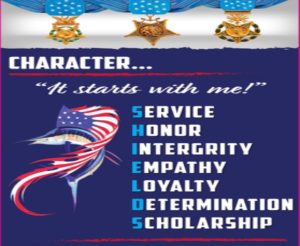Medal of Honor
The Medal of Honor is the highest award for valor in action against an enemy force which can be bestowed upon an individual serving in the Armed Services of the United States. Only 3,500 Recipients in the Army, Navy, Air Force, Marine Corps and Coast Guard have been awarded this acknowledgement of extraordinary achievement in military service.
- Navy Medal-The original Medal of Honor was designed for the Navy. The design included an inverted, five-pointed star with a cluster of laurel leaves (for victory), mixed with oak (for strength) on each of the star’s five points. The design featured Minerva, Goddess of Wisdom and War, and a man clutching snakes in his hand, representing discord, who is recoiling from Minerva. The original red, white and blue ribbon was replaced with a blue silk ribbon bearing 13 stars, symbolic of the 13 colonies. The Navy, Army and Air Force Medals now all hang from this same blue silk ribbon.
- Army Medal-he Army Medal of Honor was created soon after the original Navy Medal of Honor in 1862. The eagle, a symbol of the United States, is perched on a cannon, grasping a saber in its talons. In 1904, a new version of the Medal appeared, called the Gillespie version for its designer, Medal recipient Gen. Gillespie. A simple portrait of a helmeted Goddess of War replaced “Minerva repelling Discord.” The red, white and blue ribbon was replaced with light blue and 13 white stars.
- Air force Medal-About 50 percent larger than the other Medals, the Air Force created its Medal in 1965. The first Air Force Medal went to Maj. Bernard F. Fisher in 1967, for action in South Vietnam. The first airman to receive a Medal, however, was the famous fighter pilot Capt. Edward Rickenbacker, in 1918.
The Medal of Honor Character Development Program is a curriculum resource built on the values of courage, commitment, sacrifice, citizenship, integrity, and patriotism. Its living history videos and accompanying lessons teach students that ordinary people can meet great challenges and make the world around them a better place. Each lesson highlights skills such as writing, collaboration, and critical thinking. With two available curriculum options (elementary and secondary), the resources are appropriate for K-12 students and beyond. Assignments and activities fit efficiently into existing disciplines, time periods, and schedules.

Gary Beikirch Vietnam
Courage to Make a Difference
OBJECTIVES
Students will:
- debate whether a person’s size or intellect makes a difference in his/her contribution to society
- stand up for people who are not able to stand up for themselves
- LessonCourage Description Wheel Gary Biekirch
Nicholas Oresko:WWII
Exploring the six core values
OBJECTIVES
Students will:
- research, define and interpret the six core values
- use these definitions and interpretations in an informational essay
- Lesson A2 – Exploring the Six Core Values
In Their Own Words
Discussion Questions
- What do you think it means when the recipients of the medal express, “I am just a caretaker of the medal?”
- Why did Tibor Rubin want to come to America and fight for our country?
- Explain how John Hawk interprets “Courage”. Do you agree or disagree?Explain
- What are examples of the ways veterans demonstrated courage?
- How did Gary Biekerch define leadership?
- Discuss as a group why men and women of the arm forces have given their lives in war.
Legacy of Service
Discussion Question
- What do you think President John F. Kennedy meant when he said, “ask not what your country can do for you, but what you can do for your country?“
- How does war become “real quick” with new soldiers that enter the battle field?
- What are several examples that you observed regarding courage in combat?
- What held the soldiers together in the midst chaos and eminent death?
- Infer why it was so difficult to for the soldiers to receive the medal of honor? Why?
- What are several ways you can demonstrate sacrifice for others?
Tye Carter:Afghanistan
Selfless Service
OBJECTIVES
Students will:
- identify individuals who selflessly serve others
- analyze the impact those people have on their communities
- reflect on how they can embody the admirable qualities they recognize in others
- Lesson A1 – Selfless Service (1)
- Handout Lesson A1 Worksheet (1)
Clarence Sasser: Vietnam
OBJECTIVES
Students will:
- analyze how events develop and interact over the course of a text
- evaluate a speaker’s point of view and reasoning
- identify alternative solutions to a problem
- Lesson C7 – Overcoming Obstacles
- Sasser citation and Background Information